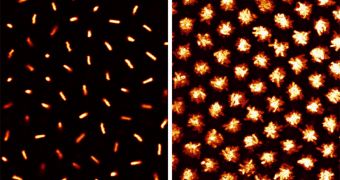A group of scientists from the FOM Foundation at the Netherlands Organization for Scientific Research (NWO) announces the development of a new method for synthesizing an interesting and unique class of new materials, called plastic crystals. Their approach relies on the use of rod-shaped particles.
Scientists have known about these plastic crystals for a long time, but thus far obtaining them in the lab has proven to be a very complex process, since this material represents a special form of matter. Such crystals are interesting because they hold great promise for improving e-ink-based color displays.
By using particles called colloid, measuring just one to a thousand nanometers in diameter, researchers were able to promote the development of plastic crystals in a solution. These crystals are closely related to the better-known liquid crystals that are already used for numerous applications.
Details of the new manufacturing technique appear in a paper published in the January 21 issue of the top scientific journal Nature Communications. The work was led by Thijs Besseling, PhD, and postdoctoral research Bing Liu, both from FOM. Professors Alfons van Blaaderen and dr. Arnout Imhof supervised the investigation.
What makes plastic crystals so special is the fact that they can be arranged in a regular 3D lattice, just like in any solid substance, except that the plastic particles can move in all directions, just like in a liquid. Therefore, these materials lie at the boundary between the liquid and solid phases of matter.
By using colloids, researchers hope to become able to investigate the special phase of plastic crystals at the particle level, something that was previously more difficult to accomplish. Due to their bizarre properties, these crystals can sometime collapse under their own weight.
During their study, the team also determined that applying electric fields to plastic crystals could turn the material into a 3D crystal boasting strict molecular order. More in-depth investigations are needed in order to understand exactly how these changes occur.
Interestingly, the former plastic glass phase returns as soon as the electric fields are switched off, the team explains. This discovery holds important implications for using this material in color e-ink displays, PhysOrg reports.

 14 DAY TRIAL //
14 DAY TRIAL //